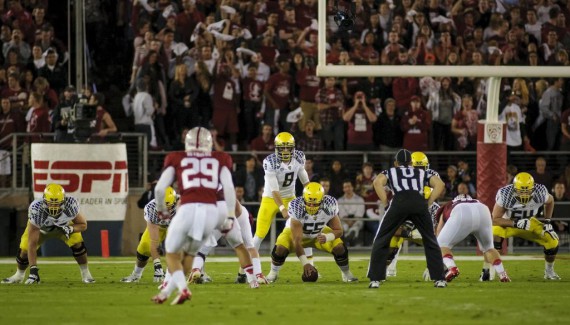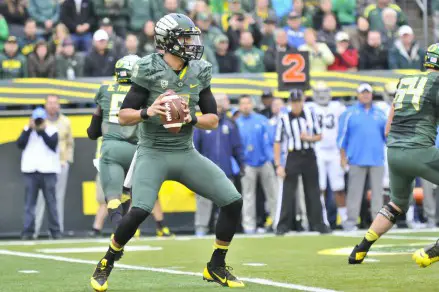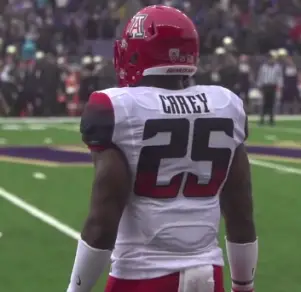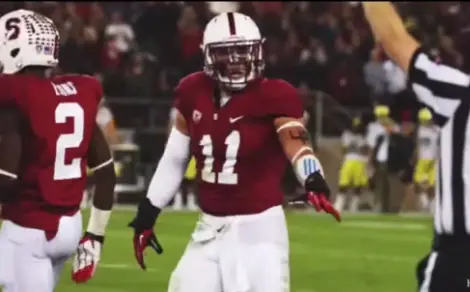When analyzed correctly, trends and patterns in recent history can help predict more about the upcoming college football season than any number of off-season projections or rankings. This is particularly the case with a team such as Oregon, which has such a distinct system and style of play.
Even the best teams have an Achilles heel, and inferior teams are often able to beat top squads with the right matchup advantages. This may sound obvious, but over the past couple of seasons, Oregon has had trouble with one particular type of team — a team that can keep the ball out of the Ducks’ hands and control the clock.
Stanford has seemed to have Oregon’s number over the last two years with that exceptional front seven, and Arizona capitalized on Marcus Mariota’s limited mobility during last season’s trip to Tucson.
These two teams have handed the Ducks their only losses since 2011, and they have established a clear pattern in the process. The difference between these games and the average convincing Oregon win has come on the ground.
In 2013, the Ducks averaged 299 rushing yards in their wins, but posted 198 yards against Arizona and only 62 against Stanford. Stanford also held Oregon to its second-lowest rushing total in its 2012 overtime win over the Ducks.
On the other side of the ball, Oregon’s high-powered offense usually forces its opponents to throw more than they pass in order to keep up. Therefore, in 2013, Oregon’s opponents in wins averaged only 39 carries per game while Stanford and Arizona ran the ball 66 and 65 times respectively.
Oregon has never had an issue conceding time of possession to its opponents. However, this is usually due to the tempo of the Ducks’ offense rather than the ability of the other team to control the clock. The problem comes when a running back such as Ka’Deem Carey of Arizona or a potent offensive line like that of Stanford is able to move the ball on the ground play after play, chew up the clock, and keep Oregon’s offense on the sideline.
Though the Ducks run a spread out, hurry-up attack, they do not shy away from running between the tackles. However, inside linebackers Shayne Skov and A.J. Tarpley have become a wall in the middle of the Stanford defense in recent years.
The strength of the Cardinal defense allowed Tyler Gaffney and the offense to control possession and slowly wear down the clock by consistently grinding out first downs behind that superb offensive line. In the 2013 matchup, this kept the ball out of Oregon’s hands for the majority of the game.
Arizona played the same game last season. Sparked by a spectacular tip-drill interception on the first play of the game, Carey and the Wildcats never cooled off after taking an early lead. Carey’s 48 carries for 206 yards and four touchdowns helped keep the Oregon offense out of the game.
Fortunately for Oregon, the Ducks’ 2014 schedule is favorable in this respect. Looking at their opponents for the upcoming season, it is unlikely that any team will be able to shut down Oregon’s rushing offense and control the clock against the Ducks with their run game.
Many would take this opportunity to direct my attention to Week 2 when Oregon hosts the Michigan State Spartans, who boasted the best statistical defense in the nation last season.
However, it is important to note that Michigan State’s numbers came against the less than spectacular 2013 edition of the Big 10, and it loses the two most important pieces of that front seven in linebackers Max Bullough and Denicos Allen.
The Spartans also lose stud cornerback Darqueze Dennard to the NFL, which should open up the passing game for the Ducks.
The aggressive MSU front and the so-called “No Fly Zone” behind it, will certainly still be a challenge to penetrate. But, while the Spartan defense may look better on paper, it does not appear to have the right matchup advantages over the Ducks as Stanford has had during the last couple of seasons.
On the other side of the ball, Jeremy Langford is a solid running back, but he is not quite as dangerous as the NFL-bound Carey, and that Michigan State offensive line is not in the same tier as Stanford’s was in 2012 and 2013, indicating a better matchup for Oregon on defense as well.
Stanford will be another major concern for the Ducks once again in 2014. However, like Michigan State, the Cardinal lose some key pieces from that elite front seven, the most notable of which has to be Skov.
Skov’s discipline against the option run and uncanny ability to time his blitzes have plagued the Ducks over the last two seasons. Stanford also loses running back Gaffney and four of its five starters on that front wall (though the new 2014 starters do have plenty of upside).
After MSU and Stanford, Oregon faces few teams capable of taking over the game as effectively as the Cardinal and the Wildcats did in 2012 and 2013.
Ifo Ekpre-Olomu leads what will be a great Duck secondary, even with several losses, and Mariota’s arm can always get the job done. Brett Hundley and UCLA posted only 64 passing yards against Oregon last season, and Washington’s Keith Price managed only 182.
While Washington, UCLA, and Oregon State, among others, will certainly present a challenge for the Ducks on both sides of the ball, no one seems to have a rushing attack capable of taking over the game and controlling the clock on offense, especially with Washington losing Bishop Sankey to the NFL.
None of this is to take away from Oregon’s opponents or to say that the Ducks’ 2014 season will be easy. It will certainly be a tough road to get through the Pac-12 unscathed. It is also not to take away from the Ducks themselves, who have for the most part dominated their competition.
Instead, it is to point out that college football ultimately comes down to certain matchups. Given the value of certain mismatches the Ducks have faced and struggled with over the past couple of seasons, fans have to be excited about the team’s 2014 outlook, as Oregon’s schedule looks to be free of the kryptonite that kept them out of the title hunt in 2012 and 2013.
Top Photo by Craig Strobeck.
Related Articles:
Chip Kelly Update: Everything's Good Again ...
Chip Kelly Update: Wailing and Gnashing of Teeth
Shock and Awe -- The Oregon Ducks' Football Hangover Effect
Despite Lopsided Score, Georgia State "Never Stopped Believing"
Hope Springs Eternal for Ducks
Incompetent Pac-12 Officials: How Do You Miss ALL of THIS?
Joey Holland graduated from the University of Oregon in 2013, majoring in History. He played several sports in high school, though football remains his passion. He has yet to miss a single Oregon Ducks home football game during his time in Eugene. Joey has written previously for Bleacher Report and Football Nation.
Joey welcomes your feedback.




